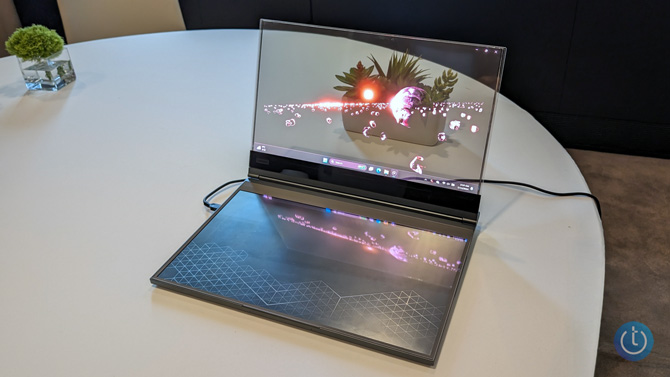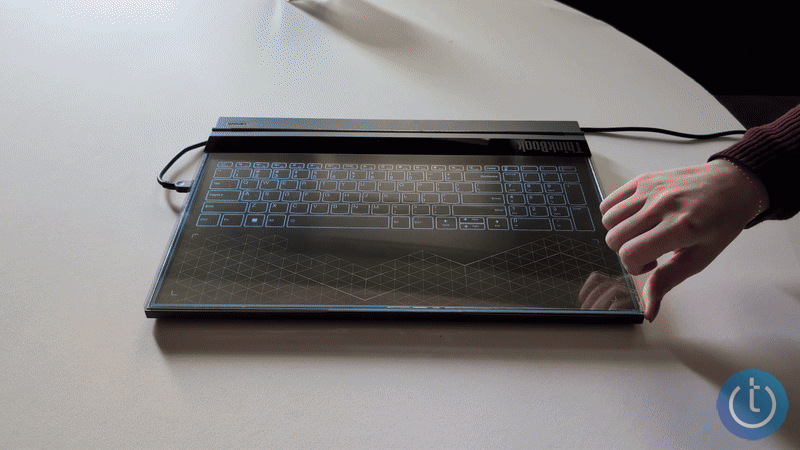Lenovo's unveiling of the ThinkBook Transparent Display Laptop at Mobile World Congress presents a fascinating glimpse into what might be the next frontier in personal computing. With its 17.3-inch Micro-LED transparent display, this proof-of-concept device proposes a new way of interacting with digital content that blends seamlessly with the physical world.

I got a first glimpse of the display and some hands-on time during a press preview earlier this month. And the sight of the large bezel-less display just sort of hanging out in space above the laptop was eye-catching and completely disruptive to my normal perception of what a laptop should be. But after playing around with it for a bit, ideas start to pop into your brain for how the potential applications of a transparent display could extend far beyond the conventional uses of a typical computer:
- Design and Art: Artists and designers could overlay their digital creations onto physical objects, allowing for real-time comparison and integration of art with real-world materials. Imagine a fashion designer projecting new patterns directly onto fabrics or a graphic artist seeing their digital sketches come to life on paper.
- Education and Training: This technology could revolutionize teaching methods by combining physical and digital elements in educational settings. Biology students could examine digital cross-sections of an organ overlaid on a physical model, while engineering students could see CAD designs projected over physical prototypes, enhancing understanding and engagement.
- Collaborative Workspaces: The transparent display could reinvent collaboration in workspaces. Team members could work on digital projects while maintaining eye contact and engaging with physical objects in shared spaces, fostering a more interactive and connected work environment.
- Healthcare: In medical fields, the ability to overlay digital images, such as MRI scans or anatomical diagrams, onto a patient model could aid in education, diagnosis, and patient communication, providing a clearer understanding of complex medical conditions.
- Retail and Fashion: The fashion industry could use transparent displays for interactive fitting rooms, where customers can see digital representations of clothing items superimposed on their reflection, offering a futuristic shopping experience.
- Architecture and Real Estate: Architects could project their 3D models onto physical spaces, providing clients with a tangible sense of how a design integrates with its intended environment. Similarly, real estate agents could use it to overlay virtual furniture and decor in empty spaces, enhancing property presentations.

Following the buzz around LG's transparent OLED TVs at CES 2024, Lenovo's venture into transparent computing devices underscores a broader trend towards integrating digital displays into our physical environments in a more meaningful way. While LG's technology primarily enhances the aesthetic and immersive qualities of home entertainment, Lenovo's transparent laptop aims to revolutionize productivity, creativity, and collaboration by merging digital and physical workspaces.
Read more: LG's Signature OLED T TV Vanishes into Thin Air
As this technology evolves, I anticipate further enhancements in display quality, user privacy options, and interactive capabilities. In the current iteration, there was no option for protecting your privacy from viewers on the other side of the display. But this is just a prototype, and Lenovo indicated they are exploring various privacy solutions. The challenge for Lenovo will be to refine and adapt these concepts to meet practical needs while overcoming limitations such as battery life, durability, and processing power.
[Image credit: Josh Kirschner/Techlicious]
Josh Kirschner is the co-founder of Techlicious and has been covering consumer tech for more than a decade. Josh started his first company while still in college, a consumer electronics retailer focused on students. His writing has been featured in Today.com, NBC News and Time.














